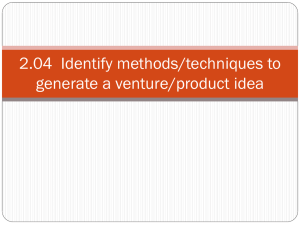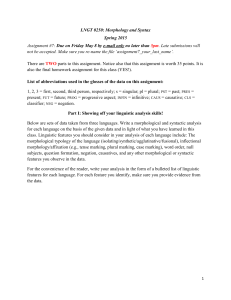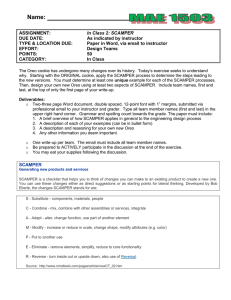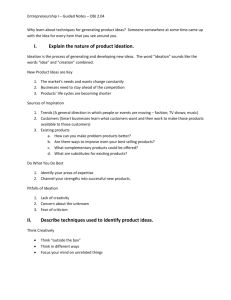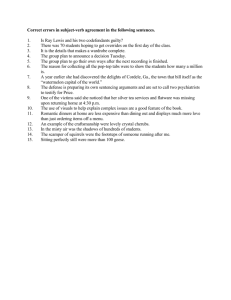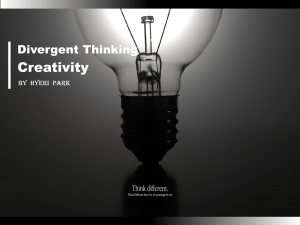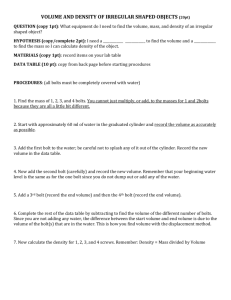Creativity Techniques
advertisement
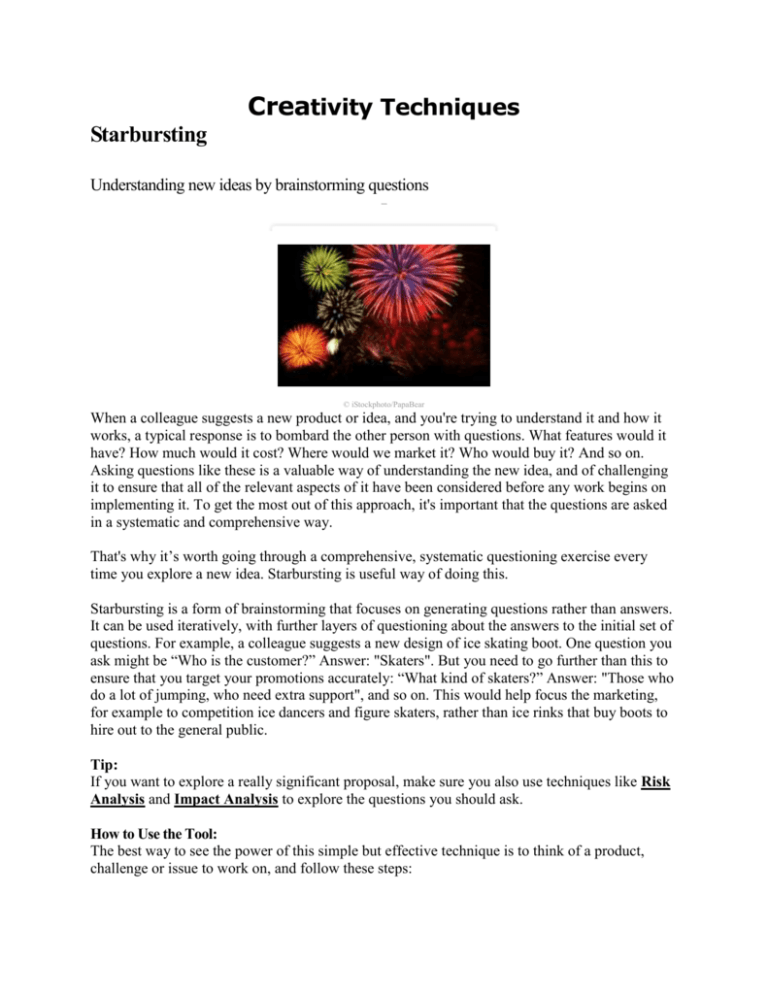
Creativity Techniques Starbursting Understanding new ideas by brainstorming questions © iStockphoto/PapaBear When a colleague suggests a new product or idea, and you're trying to understand it and how it works, a typical response is to bombard the other person with questions. What features would it have? How much would it cost? Where would we market it? Who would buy it? And so on. Asking questions like these is a valuable way of understanding the new idea, and of challenging it to ensure that all of the relevant aspects of it have been considered before any work begins on implementing it. To get the most out of this approach, it's important that the questions are asked in a systematic and comprehensive way. That's why it’s worth going through a comprehensive, systematic questioning exercise every time you explore a new idea. Starbursting is useful way of doing this. Starbursting is a form of brainstorming that focuses on generating questions rather than answers. It can be used iteratively, with further layers of questioning about the answers to the initial set of questions. For example, a colleague suggests a new design of ice skating boot. One question you ask might be “Who is the customer?” Answer: "Skaters". But you need to go further than this to ensure that you target your promotions accurately: “What kind of skaters?” Answer: "Those who do a lot of jumping, who need extra support", and so on. This would help focus the marketing, for example to competition ice dancers and figure skaters, rather than ice rinks that buy boots to hire out to the general public. Tip: If you want to explore a really significant proposal, make sure you also use techniques like Risk Analysis and Impact Analysis to explore the questions you should ask. How to Use the Tool: The best way to see the power of this simple but effective technique is to think of a product, challenge or issue to work on, and follow these steps: Step 1 Download our free worksheet and print it out or take a large sheet of paper, draw a large sixpointed star in the middle, and write your idea, product or challenge in the centre. Step 2 Write the words Who, What, Why, Where, When and How at the tip of each point of the star. Step 3 Brainstorm questions about the idea or product starting with each of these words. The questions radiate out from the central star. Don't try to answer any of the questions as you go along. Instead, concentrate on thinking up as many questions as you can. Step 4 Depending on the scope of the exercise, you may want to have further starbursting sessions to explore the answers to these initial questions further. Figure 1 below shows some of the questions you might generate in a short starbursting session, focused on the skates mentioned above. Key Points: Starbursting is a form of brainstorming used to generate questions in a systematic, comprehensive way. It’s a useful tool to support your problem solving or decision making processes by helping you to understand all aspects and options more fully. SCAMPER Improving Products and Services SCAMPER is a checklist that helps you to think of changes you can make to an existing product to create a new one. You can use these changes either as direct suggestions or as starting points for lateral thinking. Developed by Bob Eberle, the changes SCAMPER stands for are: S – Substitute – components, materials, people. C – Combine – mix, combine with other assemblies or services, integrate. A – Adapt – alter, change function, use part of another element. M – Modify – increase or reduce in scale, change shape, modify attributes (e.g. colour). P – Put to another use. E – Eliminate – remove elements, simplify, reduce to core functionality. R – Reverse – turn inside out or upside down, or use Reversal. Example: As an example, imagine that you are a manufacturer of nuts and bolts, and you were looking for new products. SCAMPER would give you: Substitute – use of high tech materials for niche markets, such as high speed steel? Carbon fiber? Plastics? Glass? Non-reactive material? Combine – integrate nut and bolt? Bolt and washer? Bolt and spanner? Adapt – put Allen key or Star head on bolt? Countersink head? Modify – produce bolts for watches or bridges? Produce different shaped bolts (e.g. screw in plugs)? Pre-painted green bolts? Put to another use – bolts as hinge pins? As axles? Eliminate – Eliminate nuts, washers, heads, thread. Reverse – make dies as well as bolts, make bolts that cut threads for themselves in material. Using SCAMPER here has helped you define possible new products. Many of the ideas may be impractical or may not suit the equipment used by the manufacturer. However some of these ideas could be good starting points for new products. Key Points: SCAMPER is an acronym for Substitute, Combine, Adapt, Modify, Put to another use, Eliminate, Reverse. This is a list of changes that you could make to existing products and services to open up new opportunities. Attribute Listing, Morphological Analysis and Matrix Analysis Tools for creating new products and services How could this basic product be changed? © iStockphoto/malerapaso Attribute Listing, Morphological Analysis and Matrix Analysis are good techniques for finding new combinations of products or services. They are sufficiently similar to be discussed together. We use Attribute Listing and Morphological Analysis to generate new products and services. How to Use the Tools: To use the techniques, first list the attributes of the product, service or strategy you are examining. Attributes are parts, properties, qualities or design elements of the thing being looked at. For example, attributes of a pencil would be shaft material, lead material, hardness of lead, width of lead, quality, color, weight, price, and so on. A television plot would have attributes such as characters, actions, locations, and weather. For a marketing strategy you might use attributes of markets open to you, uses of the product, and skills you have available. Draw up a table using these attributes as column headings. Write down as many variations of the attribute as possible within these columns. This might be an exercise that benefits from brainstorming. The table should now show all possible variations of each attribute. Now select one entry from each column. Either do this randomly or select interesting combinations. By mixing one item from each column, you will create a new mixture of components. This is a new product, service or strategy. Finally, evaluate and improve that mixture to see if you can imagine a profitable market for it. Example: Imagine that you want to create a new lamp. The starting point for this might be to carry out a morphological analysis. Properties of a lamp might be power supply, bulb type, light intensity, size, style, finish, material, shade, and so on. You can set these out as column headings on a table, and then brainstorm variations. This table is sometimes known as a "Morphologial Box" or "Zwicky Box" after the scientist Fritz Zwicky, who developed the technique in the 1960s. Power Supply Bulb Type Light Intensity Battery Halogen Low Mains Bulb Solar Daylight High Size Style Very Large Modern Medium Large Crank Gas Oil/Petrol Flame Hand held Black Antique White Medium Roman Generator Colored Variable Small Finish Metallic Material Metal Ceramic Concrete Art Terracotta Bone Nouveau Industrial Enamel Glass Ethnic Natural Wood Fabric Stone Plastic Interesting combinations might be: Solar powered/battery, medium intensity, daylight bulb – possibly used in clothes shops to allow customers to see the true color of clothes. Large hand cranked arc lights – used in developing countries, or far from a mains power supply. A ceramic oil lamp in Roman style – used in themed restaurants, resurrecting the olive oil lamps of 2000 years ago. A normal table lamp designed to be painted, wallpapered or covered in fabric so that it matches the style of a room perfectly. Some of these might be practical, novel ideas for the lighting manufacturer. Some might not. This is where the manufacturer's experience and market knowledge are important. Key Points: Morphological Analysis, Matrix Analysis and Attribute Listing are useful techniques for making new combinations of products, services and strategies. You use the tools by identifying the attributes of the product, service or strategy you are examining. Attributes might be components, assemblies, dimensions, color, weight, style, speed of service, skills available, and so on. Use these attributes as column headings. Underneath the column headings list as many variations of that attribute as you can. You can now use the table or "morphological box", by randomly selecting one item from each column, or by selecting interesting combinations of items. This will give you ideas that you can examine for practicality. Notes: Attribute Listing focuses on the attributes of an object, seeing how each attribute could be improved. Morphological Analysis uses the same basic technique, but is used to create a new product by mixing components in a new way. Matrix Analysis focuses on businesses. It is used to generate new approaches, using attributes such as market sectors, customer needs, products, promotional methods, and so on. CREATIVITY ENHANCING TECHNIQUES 1. ASKING QUESTIONS: * a. A question is an opening to creation. b. A question is an unsettled and unsettling issue. c. A question is an invitation to creativity. d. A question is a beginning of adventure. e. A question is seductive foreplay. f. A question is a disguised answer. g. A question pokes and prods that which has not been poked and prodded. h. A question is a point of departure. i. A question has no end and no beginning. j. A question wants a playmate. 2. IMAGRY: ** a. Relax. b. Ask your intuition for an appropriate image, i.e. a symbol, scene or image. c. Accept whatever image emerges. Surrender (don't judge or sort). d. Make the image vivid. Encourage emotions and many sense modes (feelings, sights, sounds, smells, tastes). e. If you don't understand the image, ask your intuition for another one. f. Enjoy the images. “There is no use in trying,” said Alice. “One can't believe impossible things.” “I dare say you haven't had much practice," said the Queen. "When I was your age, I always did it for half-an-hour a day. Why, sometimes I've believed as many as six impossible things before breakfast.” – Lewis Carroll, Alice in Wonderland. 3. 4. 5. 6. 7. 8. 9. BRAINSTORMING (see “Better Brainstorming”). ANALOGY (similarity between two things otherwise dissimilar, i.e. velcro is like burdock burrs clinging to clothes). DREAMS: (Walt Disney said, "If you can dream it, you can do it." The navigators in “Dune” dreamed they were somewhere else, and they were.) DRAWING: (doodle to evoke images and connections). MEDITATING: (mind clearing). MATRIX ANALYSIS (what is a painting?) SCAMPER a. Substitute? b. Combine? c. Adapt? d. Modify? e. Put to other uses? f. Eliminate? g. Reverse? (roles, look at things upside down). Rearrange? (patterns, space, components). 10. CREATIVITY BLOCKS: a. Accepting conventional wisdom as an appropriate approach. b. Lacking time to investigate or elaborate on new ideas. c. Seeking only to satisfy the perceived needs of bosses. d. Having tunnel vision, compartmentalizing problems. e. Looking for quick yes/no answers. f. Fearing rejection of ideas. g. Being afraid of making mistakes. h. Expecting others to be the creative ones ("I'm not creative" excuse). i. Being unwilling to question others. j. Being unwilling to accept others' input. k. Being unwilling to collaborate. 12. CREATIVITY ENHANCERS: a. Assume that every experience you have can positively stimulate your personal growth. b. Discover the fundamental truth and the fundamental illusion in the barriers you face. c. Clearly envision how you want to be (what you want to be doing and having). d. Evoke the situation and emotions surrounding the block, holding strongly to your vision and your inner strength. e. Take action and/or communicate with another person. f. Allow yourself time. H ave patience and honor the seasons of creativity. PICASSO: "Art is a lie that makes us realize the truth." * Ray, M., and R. Myers, Creativity in Business, Doubleday & Co., New York, 1986. ** Miller, W.C., The Creative Edge, Addison-Wesley, Reading, Massachusetts, 1987. The Techniques, Blocks and Enhancers in this outline are suggested by Miller.
